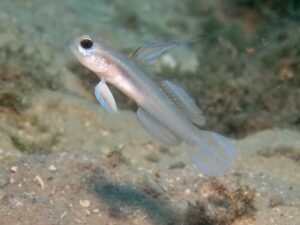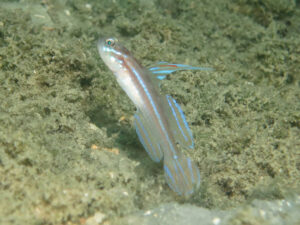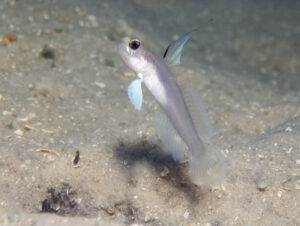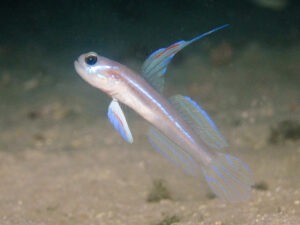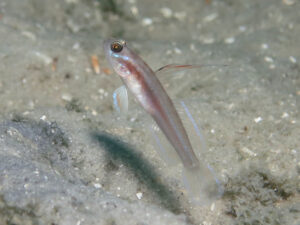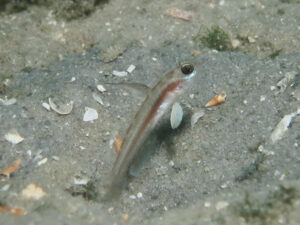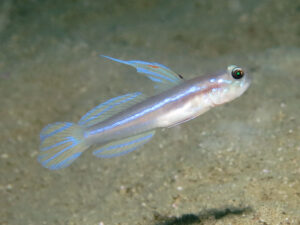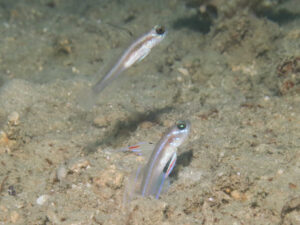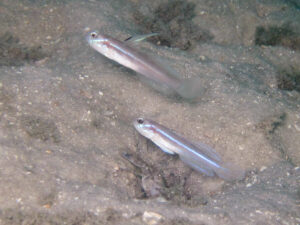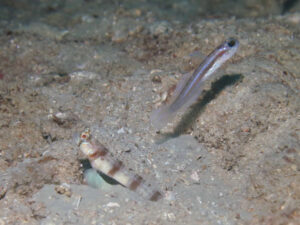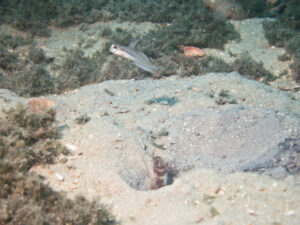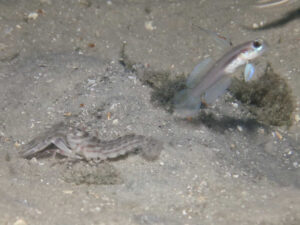Larson’s Shrimpgoby
Stonogobiops larsonae
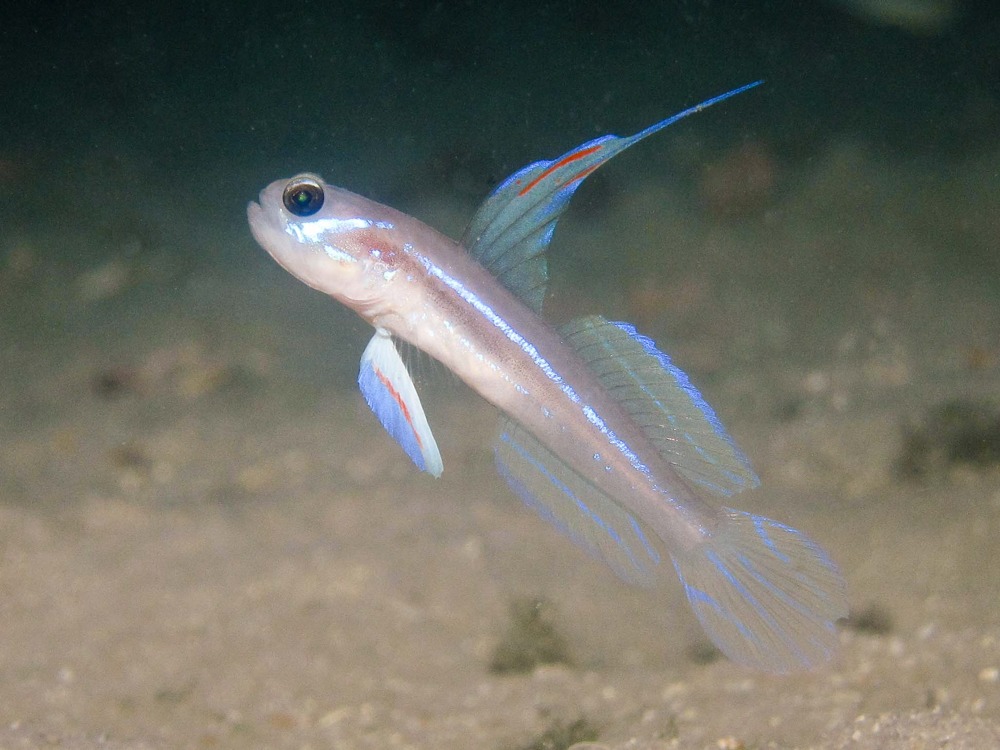
Larson’s Shrimpgoby
Stonogobiops larsonae
(Allen, 1999)
Description
A small transparent-looking goby that characteristically hovers at an angle just above the burrow entrance, suspended there by rapid sinuous beating of its broad circular tail. Males and females differ in their fin designs and markings.
Body design
The head and body are uniformly grey-brown apart from a tapered red-brown mid-lateral stripe running from a short distance behind the eye to the caudal peduncle. Below this, the body is silvery white. from below the jaw to the origin of the anal fin. Above and running parallel to the mid-lateral line is a fine pale line which in the male shows brilliant blue reflectivity in appropriate light. A broken brown line runs along the dorsum.
The female colour pattern has a clear affinity with the male pattern but has more of a red tinge. The line running along the top of the brown stripe is not so readily reflective and usually looks unreflective ochre.
Head
The head is uniformly grey-brown in both sexes. A short reflective line runs from the anterior to the mid-lateral line to below the eye. There are two other reflective spots on the gill cover below the extension of the mid-lateral line.
Fin design
The first dorsal fin in the male is tall and sickle-shaped with a greatly extended third ray. It is translucent grey with the fin rays iridescent blue distally. Between the second and third ray and between the third and fourth are red streaks and there is a black edge to the first ray.
In the female, this fin is the same shape but is more subtlety marked being plain blue with a black leading edge
The rectangular second dorsal fin in the male is greenish with an iridescent pale blue stripe midway and a brighter darker blue reflective edge The anal fin is a mirror image of this. the tail is greenish with radiating blue rays and a blue continuation of the dorsal and anal fin pattern top and bottomThe pelvic fin is brightly coloured, pale yellow then red, then blue distally.
In the female, the second dorsal, anal and caudal fins are of the male shape but are translucent grey with a blue tinge distally and are not reflective. The pelvic fin is uniformly blue, without the yellow and red colour.
Juvenile
Most small individuals seem to have female colouration. It is not clear whether this includes immature males that change as they mature but there are a few individuals with an intermediate colour pattern.
Diagnostic features
These very small gobies are best found by looking along the sea bed from a low angle. They typically hover just over the burrow entrance with the long dorsal fin extended.
The colour pattern is not obvious. They tend to look transparent until illuminated when a vivid blue stripe appears in males and a brown stripe in females. Then they are distinctive.
Natural History
Habitat
At Frazer Island, this goby seems to be restricted to a depth range of 14 to 18 metres. This includes an area where the sandy seabed is 50% covered by 10 cm deep drifts of unattached algae. Within this patchwork habitat up to six shrimp and goby pairs may be found in a square metre area of bare sand, but not in the surrounding algae that is sometimes the home of more robust species.
On North East Percy Island we have found them on extensive sand flats at 10 metres with patchy growth of Halophila minor and Halophila spinulosa. At Low Isles and Fitzroy Island, they occupy localised areas of flat silt with little Halophila at 6 to 10 metres.
They are a small species and tend to hover above the entrance to the burrow. They are very quick to disappear at the slightest movement and slow to re-emerge. They are difficult to see in the low-visibility water at all of these sites.
We have mapped the distribution of this shrimpgoby at Hervey Bay off the west coast of Frazer Island in some detail. The seabed here is fairly uniform sand, gradually getting deeper as you go offshore. We found them in an area approximately 8 km long and about 2 km offshore. We have not seen them further south of this area although the environment appears the same.
The distance offshore is determined by depth. They are mostly in 14 to 18 metres and we did not see them shallower than 12 metres. The northern limit of the longshore distribution is where the algal cover exceeds 50%. The southern limit is unexplained as the substrate does not seem to change.
Behaviour
They hover in the water above the burrow sometimes in pairs but more usually one at a time. They erect their fins in display to other Larson’s Shrimpgobies and when they are threatened by the approach of other gobies.
We have seen Larson’s Shrimpgoby sharing a burrow with the Y-bar Shrimpgoby, Cryptocentrus fasciatus and the Longspine Shrimpgoby, Amblyeleotris macronema. It is hard to imagine that this is a long-term arrangement.
Distribution
Published distribution:
Originally described from Cassini Island in north Western Australia.
Our records: (range extension)
Australia; we have found them at Hervey Bay near Frazer Island, Blunt Bay at North East Percy Island, Fitzroy Island and Low Isles, near Cairns, Queensland.
Associated Shrimp species
Associated Shrimp (one shrimp)
Diagonal Barred Snapping Shrimp, Alpheus rapacida

